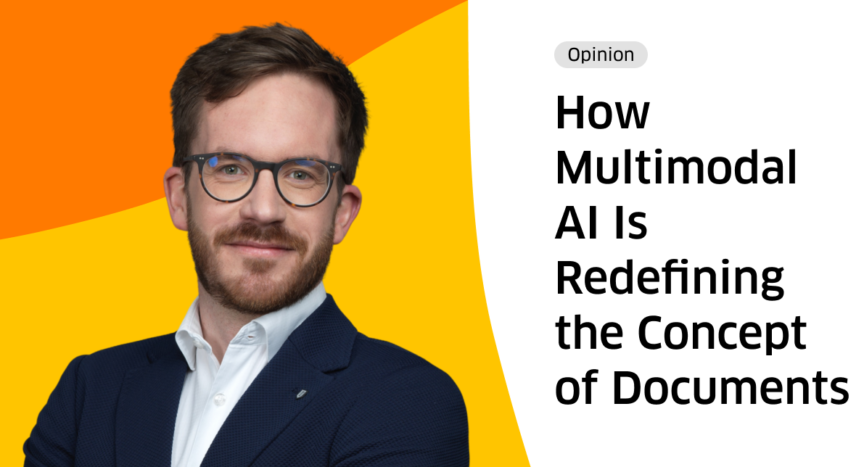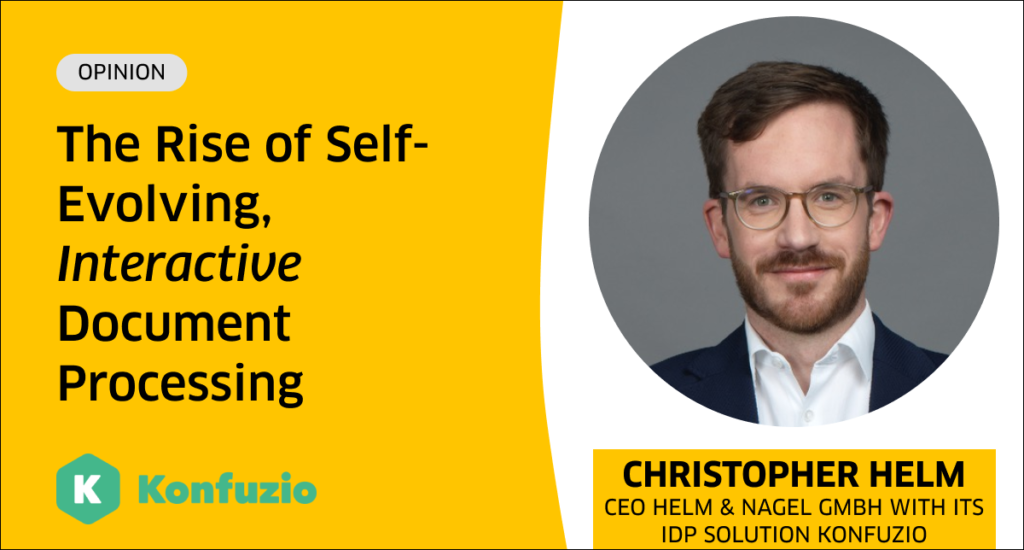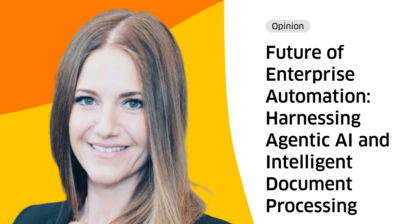Curious about what keeps experts, CEOs and other decision-makers in the Intelligent Document Processing (IDP) space on their toes? Get food for thought on IDP-related topics from the industry’s leading minds.
In this opinion piece, Christopher Helm, CEO of Helm & Nagel GmbH with its Intelligent Document Processing (IDP) solution Konfuzio, explains why a document no longer is an object, and what long-term significance this shift – from static data silos to adaptive systems – has.
In the daily grind of remote work or corporate offices, it is easy to overlook the things we interact with the most: documents. These unassuming building blocks of work seem inert—formats to be opened, skimmed, signed, or archived. But this perception is about to change in ways that will impact not just those managing complex enterprise workflows but anyone trying to stay productive — whether from a corporate tower or their kitchen table.
Because while advances in multimodal AI are fundamentally changing the way Intelligent Document Processing works, why should the concept of documents remain the same?
Breaking Boundaries: The Rise of the Fluid Document
Traditionally documents have been static carriers of information: Contracts, reports, invoices, meeting notes—they have always been defined as fixed objects we create, share, and file away. Their roles were limited to holding data or summarizing events. But in the context of Text-to-Speech (TTS), Speech-to-Text (STT), and multimodal AI models, a document is increasingly conceptualized as a dynamic and adaptive entity rather than a static or fixed file. This emerging definition expands the traditional boundaries of what qualifies as a document, considering it as a multidimensional construct capable of interacting across various modalities such as text, speech, images, and other data formats.
A document is no longer an object; it is a function. Its form is determined only by its user’s need.
At the center of this transformation is a concept we call the fluid document. Think of it as an entity free of format constraints — a document that morphs and adapts to the demands of its user and the context of its use. They are no longer static representations of data; they are adaptive, dynamic entities — actively shaping workflows, anticipating decisions, and becoming collaborative participants in how we work.
Here are some examples of this fluid transformation:
- A meeting transcript (STT) transforms into an audio briefing (TTS), then condenses into a visual mind map.
- An email draft translates into a narrated video presentation with highlights drawn from attached tables or reports.
- A research paper softens into summarized voice prompts, then reconfigures as a slide deck for collaborative editing.
- A PDF policy manual evolves into interactive speech-based training modules, adapting its depth based on user queries.
A Cognitive Brain for the Enterprise
The long-term role of this shift—from static data silos to adaptive systems—is larger than many realize. These reimagined documents are not simply tools for efficiency; they are organizational intelligence systems. Imagine for a moment an enterprise where fluid documents do more than supply information. They connect dots between silos, surfacing patterns and drawing conclusions that human teams don’t have the range of perception to piece together.
For example, a procurement system automatically benchmarks new vendor bids against historical performance data to detect cost-saving opportunities. Human resources tools analyze onboarding questionnaires and correlate common themes with long-term retention rates. Even something as routine as a product design report uses fluidity to morph into cross-department visualizations that drive collaboration between engineering, marketing, and executive teams. These are not traditional documents; they are functional nodes in a company’s cognitive system—aiding individuals while advancing a collective organizational intelligence.
The Future of Work Is Embedded in Fluidity
The way we use information, and in particular the role of Intelligent Document Processing, is evolving hand in hand: Documents, once carriers of static information, now influence and amplify workflows. IDP software, originally only introduced for input management to automate external mail and archives, is now becoming a data hub that is geared to the user. As a result, the number and possible scope of use cases is growing considerably. This transition is already happening, but it is up to business leaders to embrace it responsibly. By adopting AI-powered document systems—not for short-term automation but for long-term fluidity—organizations will gain more than productivity.
They will build smarter, more agile ecosystems where collaboration happens faster, insights emerge naturally, and decisions improve continuously. For those willing to abandon the confines of traditional documents, the opportunity is boundless. Those who hesitate risk finding their static, siloed workflows unable to compete in a world where information has already evolved into fluid, functional intelligence. The new nature of documents is here—and it’s transforming more than paperwork. It is redefining work itself.

About the Author
Christopher Helm is CEO of Helm & Nagel GmbH, an international provider of artificial intelligence (AI) and new enabling technologies. Among those is the software Konfuzio, an AI-based platform for process optimization and data-based knowledge gain.
📨Get IDP industry news, distilled into 5 minutes or less, once a week. Delivered straight to your inbox ↓








